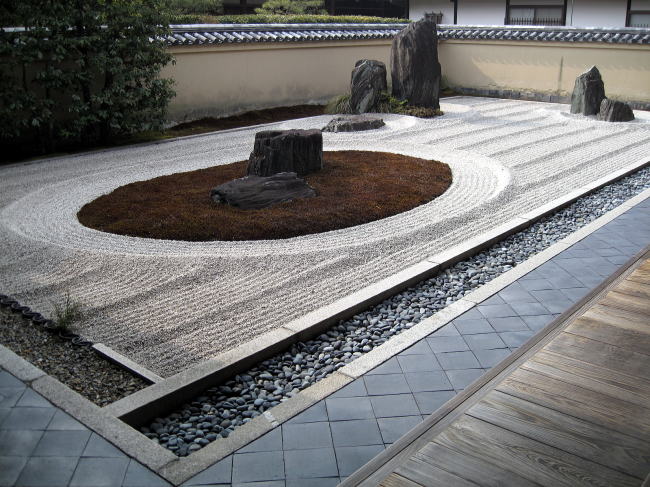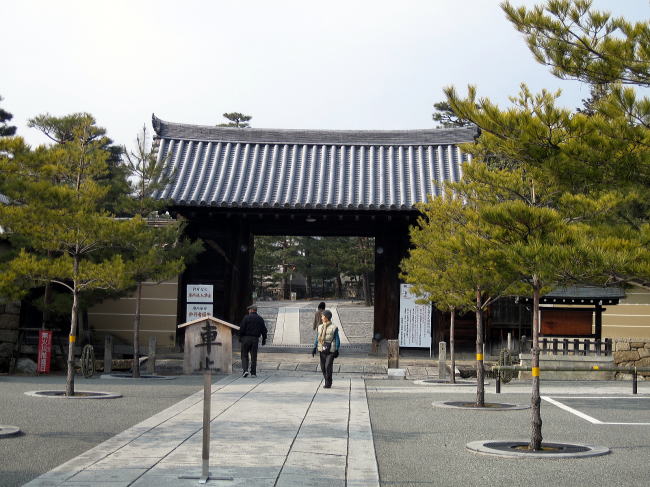Weekly Topics/Archive
February 2011
|
I went into the temple grounds of Daitoku-ji temple through its general
gate.
People can freely walk up and down the temple grounds.
There are no admission fees to Daitoku-ji Temple.
Occasionally, I meet some people who enjoy walking or dog-walking in the
grounds.
|
|
Map of the temple grounds
of Daitoku-ji.
|
Click the picture to see a full-size version.
Daitoku-ji is a Buddhist temple, one of the branches of the Rinzai school
of Japanese Zen.
It was established in 1325 by Shuho Myoho, more generally known as Daito
Kokushi.
Anyway, I was very surprised at a large area of the temple ground.
In the temple grounds , there are two branch temples and 22 subtemple as
well as the
main buildings, Shichido garan, peculiar to Zen temple.
Compared it to a holding company, I felt it's similar to the scheme that
there are 24
subtemples as subcompanies under control of a holding company named Daitoku-ji.
I decided to visit all the subtemples available to the public.
By each of these subtemples as the operational company, visitors were charged
an entrance fee between 300 and 600 yen according to their cultural value.
Since it was a fee structure convenient to the temple side, it looked like they were always out
to make a buck.
I hope Daitoku-ji dosn't run toward excessive commercialism.
Since I visited as many as five subtemples, thing in question here is a
mere entrance fee,
but the total entrance fees became a considerable cost burden to me as
a pensioner.
One of this temple's features is that each of subtemples has fine rock
gardens called "kare-sansui" within their grounds.
There may be nothing surprising about this because it's a Zen temple.

Issi-dan, a garden in front of hojo of Ryogen-in which is a subtemple of
the Daitoku-ji |
It's fun for you to sit down on a red carpet laid on the floor of hojo,
face nature of
"kare-sansui" and then meditate blocking out your worldly thoughts
to rise above self.
Both Kencho-ji and engaku-ji temple on the mountainside in Kamakura, which
belong to
the same Rinzai School of Buddhism Zen as Daitoku-ji temple, are in the
temple grounds
with gentle slope.
They create their own good atmosphere.
However, it's also good that the whole of the temple ground is flat like
Daitoku-ji.
Another big feature is that many of the subtemples are family temples of
famous warlords
or feudal lords.
For examle, Soken-in shown to the public now is Oda family's temple.
In this temple's ground, there is his family grave which the markers of
Nobunaga and his
lineal relatives stand in neat row.

Karamon
(chinese-stylegate)
of Soken-in |
|
|
Nobunaga's family
grave
|
Click the picture to see a full-size version.
The seated statue of Nobunaga, which has been desinated as a Important
Cultural Property, was shrined in the main hall here.
It is said two life-size seated statue of Nobunaga were created at that
time, and one of them
was cremated as a substitute for his remains because there were no remains of him
after Honnoji Incident.
I took about 4 hours from around 10:30 a.m. to look around the temples.
For more details on the picture of Daitoku-ji,please visit the following
link.
 Picture / Pilgrimage to old temples / 「京の冬の旅−龍寶山 大徳寺(1/5)」 Picture / Pilgrimage to old temples / 「京の冬の旅−龍寶山 大徳寺(1/5)」
I got to Kyoto station by the city bus from bus stop, Daitokuji-mae and then go into
the restaurant, "Machiya".
After taking a sake break with takoyaki as a snack, I went home.
Well, which temple shall I visit next time ?
[Note] admission fee ; 拝観料、 temple ground ; 境内、 branch temple ; 別院
Shuho Myoho ; 宗峰 妙超、 Daito Kokushi ; 大燈国師、 walk up and down ; 行ったり来たりする
subtemple ; 塔頭寺院、 subcompany ; 子会社、 Shichido garan ; 七堂伽藍
available to the public ; 一般に公開されている、 perational company ; 事業会社
fee structure ; 料金体系
be always out to make a buck ; 商魂たくましい (commercially-minded)
excessive commercialism ; 過度の商業主義、 as many as 〜;〜 もの数の
thing in question here is a mere 〜,but ----; たかが〜であるが,---である
considerable ; かなりの,無視できない、 kare-sansui ; 枯山水
there is nothing surprising about this. ; これは当然と言えば当然だ
hojo ; 方丈, meditate ; 瞑想する,block out ; 遮断する、 worldly thoughts ; 雑念
rise above self ; 無我の境地に入る、 family temple ; 菩提寺、 feudal lord ; 大名
grave marker ;墓標、 stand in neat row;整然と並ぶ、 life-size ;等身大の、 cremate;火葬する
as a substitute for 〜 ; 〜の代わりに,remains ; 遺骸、 Honnoji Incident ; 本能寺の変
Japanese Diary / No.343−2010.02.10 / 「京の冬の旅−大徳寺(2/2)」 Diary / No.343−2010.02.10 / 「京の冬の旅−大徳寺(2/2)」
Setsubun was on February 3rd.
On the evening of that day, we opened the doors of our houses and drove
the demons
out of our homes by throwing handfuls of beans.
So we want to be in good health throughout this year.
And on the first day of spring the following day, it was really nice warm
like spring has
come literally.
Today it isn't as warm as yesterday, but temperature climbs to 11 degrees
Celsius and it is
as warm as in March.
Though I have kept indoors until now, it's been a while since I went out because of the fine
weather.
When it gets walmer, we get active physicalley and emotionally and then have really an urge
to go out as well as hibernated insects.
My destination is Daitoku-ji Temple located in Rakuhoku area.

The general gate called somon of Daitoku-ji Temple |
I was motivated by reading the feature article of a campaign "Kyoto
Winter Special"
in the last December issue of the JR magazine, "Zipangu−club".
In this article, I saw all areas of Kyoto are holding the special public
viewing of private
cultural assets as the main event.
This is the annual campaign hosted by Kyoto City.
In commemoration of broadcast of NHK period drama, "Go: Hime-tachi
no Sengoku",
the theme of this year's special public opening is "Warlords and Princesses of the Warring
States period".
12 temples in Kyoto are hosting the special public openning, focusing on treasured cultural
assets such as gardens, teahouses and works of art which is rarely seen
now.
In addition to it, I watched the latest NHK period drama titled "The Incident at Honnoji
Temple" last night.
In this incident, feudal lord Nobunaga Oda ended his life due to a rebellion by his general
Mitsuhide Akechi.
One of these temples hosting this special public openning is Daitoku-ji
Temple, which is
greatly linked to Nobunaga.

The seated statue of Nobunaga that is shrined in the main hall of Soken-in
and has been designated as an Important Cultural Property |
I left my home around 9 a.m. and got to Daitoku-ji Temple around 10:30
a.m. according
to "access" introduced on the campaign article.
After visiting Daitoku-ji Temple, I was going to Kinkaku Temple in the
same area.
But I coudn't afford to do that because it took almost half a day to see
Daitoku-ji.
For further details on the visit to Daitoku-ji Temple, please see the
picture on my website
updaiting after tomorrow.
To be continued later on "A one-day sightseeinf trip to Kyoto in winter
(2/2)".
[Note] Setsubun ; 節分、 drive A out of B ; BからAを追い出す(払う)
demon ; 悪霊、邪気、鬼、 a handful of 〜 ; 一握りの〜、 literally ; 文字どおりに
the first day of spring ; 立春、 keep indoors ;家に引きこもる(閉じこもる)
it's been a while since 〜 ; 久し振りに〜する、 have an urge to 〜 ; 〜したくなる
hibernated insects ; 冬眠していた昆虫、 in the December issue of 〜 ; 〜 の12 月号
special public viewing (openning);特別公開、 private Cultural Assets ;非公開文化財
period drama ; 大河ドラマ、 warlords ; 武将、 Warring States (Sengoku) period ; 戦国時代
treasured ; 貴重な,秘蔵の、 The Incident at Honnoji Temple ; 本能寺の変
feudal lord ; 大名、 rebellion ; 謀反、 be linked to 〜 ; 〜とかかわりがある
Japanese Diary / No.341−2010.02.07 / 「京の冬の旅−大徳寺(1/2)」 Diary / No.341−2010.02.07 / 「京の冬の旅−大徳寺(1/2)」
 TOPペ−ジへ戻る TOPペ−ジへ戻る
|
|